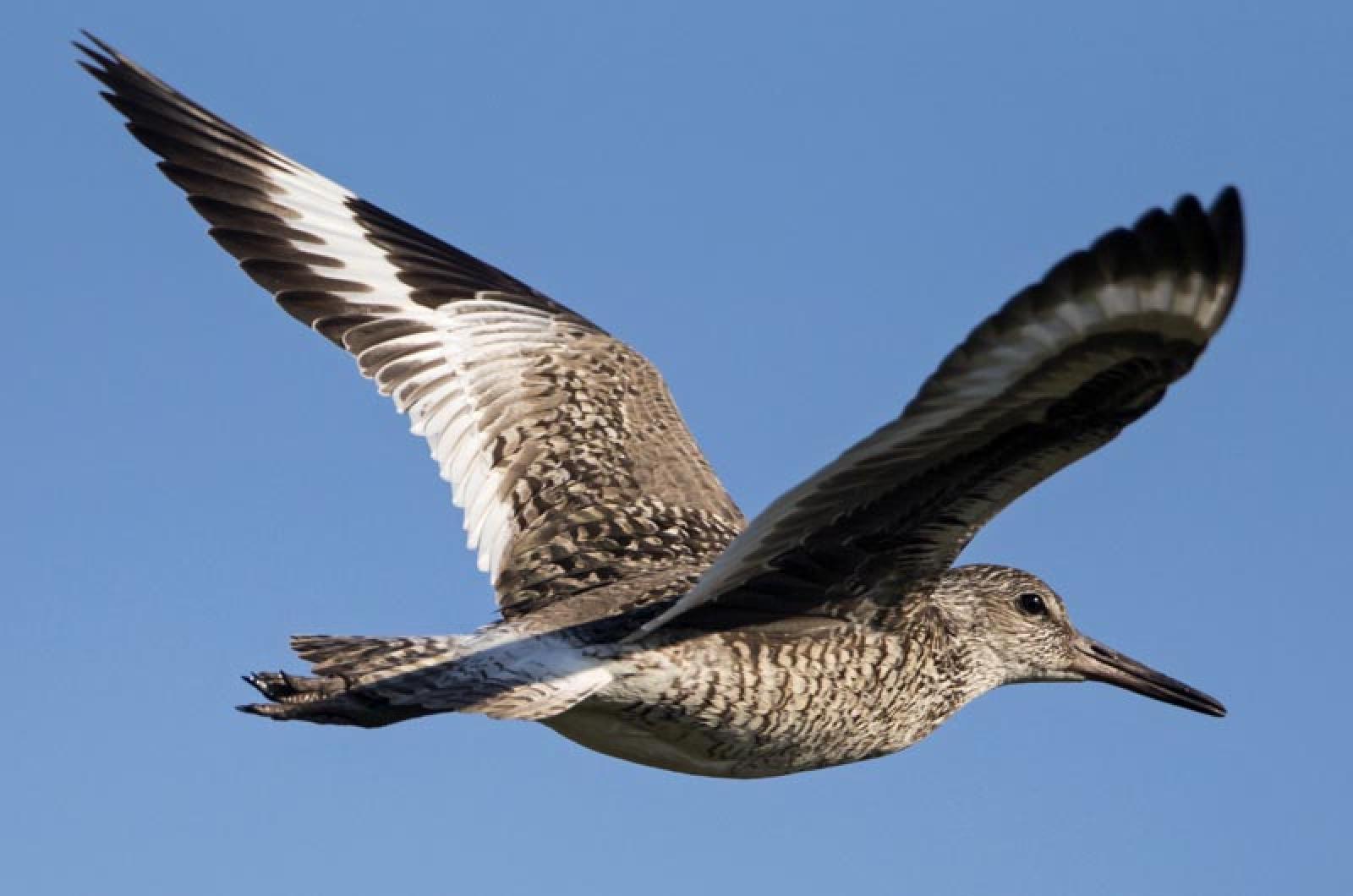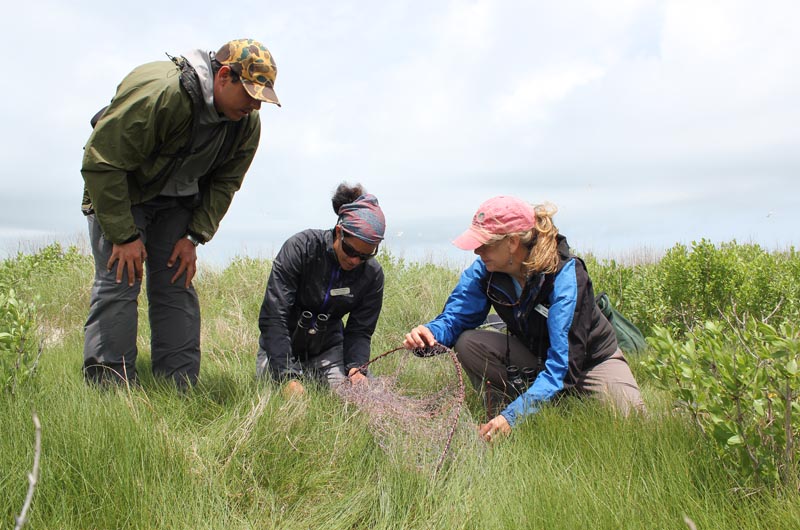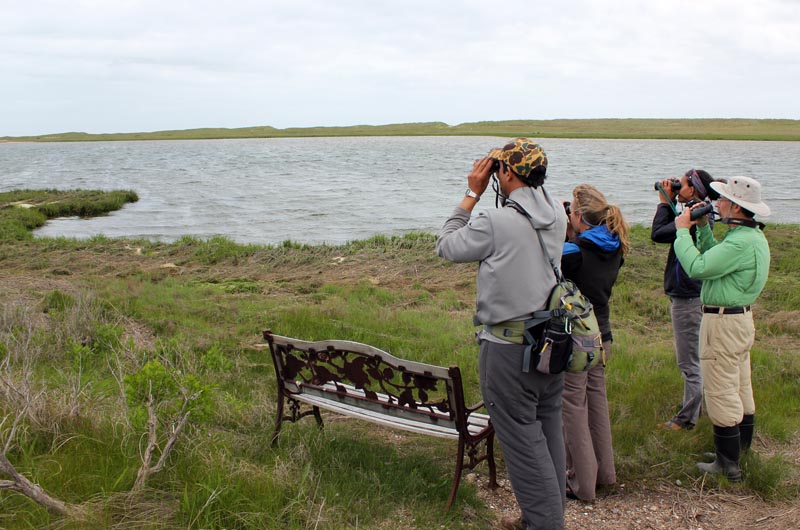On a recent early morning in June, Luanne Johnson, director and wildlife biologist at BiodiversityWorks, prepared for a mission at the Little Beach salt marsh. She had scouted out the scene earlier and she knew what lay hidden in the terrain. Buried beneath tufts of Spartina patens (salt marsh hay) was a small nest containing four distinctly marked eggs — olive green with black-brown specks and about two inches long from end to end.
“The eggs are getting close to hatching,” Ms. Johnson said, a hint of urgency in her voice.
Ms. Johnson was actually less interested in the eggs than their creator — a female eastern willet she had tagged one year earlier with a geolocator. Using money from a Gus and Catherine Daniels Wildlife Trust grant, Ms. Johnson had purchased four geolocator leg bands. With the help of her BiodiversityWorks co-workers and Joe Smith, an ornithologist from New Jersey, she affixed the geolocators to four willets last June. Now Ms. Johnson was trying to recapture those same four birds so she could retrieve their migration data. Mr. Smith has been studying eastern willets in Cape May, N.J. Those birds fly for three days straight — at speeds up to 57 miles per hour — before landing in Brazil and Suriname for the winter. BiodiversityWorks is curious whether the willets on Martha’s Vineyard follow a similar route.
Mr. Smith noted that if the data from the Vineyard willets is similar to the data from the birds he has studied, it could have a significant impact on global conservation efforts.
“The migration story is important because it brings attention to this area in South America,” said Mr. Smith. “All kinds of shorebird species are all pooling to this 500 kilometer coastline in Brazil, but it hasn’t received any attention in terms of conservation.”
The study of the willets may also reveal important information about the effects of climate change. The salt marsh, where willets breed and nest, is one of the habitats most threatened by rising sea levels. Though willets are abundant on Martha’s Vineyard right now, with their habitat in jeopardy they could decline in the coming years. “We’re trying to learn as much about willets as we can right now, while they’re still abundant, because they’re not on anybody’s radar,” said Ms. Johnson. The task of recapturing the four tagged birds is nothing short of arduous, however. “It’s easy to catch a willet,” said Ms. Johnson. “Just not that willet.”
Nature’s clock was not on the team’s side, either. A willet with a nest full of eggs has to come home once in awhile. But as soon as the eggs on Little Beach hatched and the mama bird left the nest, the mission would be ruined.
At 7:45 a.m. the team assembled and geared up.
At the end of Fuller street, where the pavement meets the sand, Ms. Johnson and Mr. Smith scanned their arsenal of willet-catching equipment. The decision was unanimous. The hand net would be used first.
Liz Baldwin, assistant director and biologist at BiodiversityWorks, was nominated as wielder of the hand net. Before embarking on her journey to the salt marsh, she received some advice from Mr. Smith.
“It works best if you’re surreptitious,” he said.
Ms. Johnson, Mr. Smith and a small crew of volunteers stayed behind while Ms. Baldwin made her way towards the marsh. A few minutes later the team walked out to the first bend of the Little Beach coastline to check on Ms. Baldwin’s progress. Everyone crouched down behind a dune so as not to be noticed by the birds, and Ms. Johnson peered between some branches with her binoculars.
Ms. Baldwin walked toward the nest, not looking at it and giving it a wide berth. Then, using only her peripheral vision, she swung the hand net over the willet nest. Nothing. The bird wasn’t home. It was time to move on to plan B: the bow net.
The bow net, unsprung, consists of two semi-circular rods folded on top of each other with netting bunched up around them. Attached to the rods is a camouflaged receiver. When a remote trigger is pulled, the rods release, with one of them snapping over the nest and encircling it with netting.
The biologists waited out of sight for 45 minutes for the willets to return to their nest. Mr. Smith finally decided it was time to “bring it.”
Knowing that the birds are least alarmed by objects in the water, Ms. Baldwin approached by kayak to trigger the net, paddling within the bow net’s 100 meter range. Mr. Smith and Ms. Johnson then hurried to the nest to see if a willet lay beneath the net. Again, nothing. Mr. Smith gently reset the net and returned to the beach to wait some more.
As the hours passed and mid-afternoon approached, the process of setting, springing and resetting the net grew cyclical. The time between setting and springing became longer and longer with each new round — 45 minutes, one hour, two and a half hours. There were technical difficulties with the trigger, too. With each failed attempt, the willets needed more time to trust their nest again. They’d always return, Ms. Johnson and Mr. Smith affirmed, but increased waiting times would yield a more promising willet harvest. At least that was the idea.
Time, though it was finite, didn’t seem to bother the biologists. Patience seemed to flow freely through their blood. It was what allowed them to be successful ornithologists. Buffalo jerky and peanuts helped pass the time. So did storytelling. Mr. Smith and Ms. Johnson exchanged tales about past birding excursions. Mike Kilpatrick, Mr. Smith’s cousin and the person who ignited his passion for nature, spoke of Thoreau and the “real naturalists,” whose reverence for nature and emotionally evocative writing have slipped out of the modern vernacular.
As the afternoon came to a close, it was time for the day’s final attempt. It was decided that the bow net would be triggered from land this time. But even before the net was sprung, Ms. Johnson knew the day would not end in success. Through her binoculars, she could see the female willet staring back at her. Smug or deliberately indifferent, it was difficult to tell.
The crew packed up their toolboxes and nets and headed home for the day. On Friday they headed to Chappy, but the only thing the team caught was some rain. On Saturday, they were back at Little Beach. Once again the morning commenced with a hand net attempt, then the bow net trials began.
Mr. Smith, Ms. Johnson, Ms. Baldwin and Mr. Kilpatrick brainstormed new approaches to springing the bow net. What about asking a tourist to trigger the net from the shore? Or how about approaching the marsh from a different direction in the kayak? The team joked about employing a drone or coordinating a night attack. One thing was certain, though, the biologists had to remain sidelined. The willets now knew who they were.
“They can tell a biologist from a biologist acting like a non-biologist,” Mr. Smith said.
“They can tell a herring from a person acting like a herring,” Mr. Kilpatrick added. “We tested that, too.”
After the second springing of the bow net on Saturday, Mr. Smith and Ms. Johnson waited for even longer periods to reset the net. Eventually, they did catch a willet.
“We got the male,” Mr. Smith called out as he stepped over the low fence that separates the nesting grounds from the beach.
At the nesting site, Mr. Smith and Ms. Johnson had sheathed the bird in a yellow cloth sleeve (informally called the “willet sock”) in order to ease its anxiety. Putting a bird in the dark relaxes it so that biologists can handle it more readily, said Ms. Johnson.
Though the willet in Mr. Smith’s hands was not the willet of interest, as the mate of the bird they were trying to capture, he was still useful to the mission. Without the male on the nest incubating the eggs, the female willet would most likely return home. But now another clock was ticking. Without a state permit, the male willet could only be held captive for an hour.
Ms. Johnson and Mr. Smith took advantage of the hour by taking a series of measurements of the captured male willet. He had color bands on his legs — yellow over yellow on his right and aluminum over orange on his left — indicating that BiodiversityWorks had encountered him before. After recording his mass and wing length, Ms. Johnson compared the numbers to their data on him from last year. Nothing had changed.
The hour passed. It was time to release the bow net. The week’s tension, gentle but existent, lay bundled in this moment.
From the apex of Little Beach’s point, the bow net was sprung. Ms. Johnson and Mr. Smith walked out to the marsh. They crouched by the nest and lingered there. Again, nothing. As they walked back towards the beach, the willet sock hung limply from Mr. Smith’s pocket.
Reluctantly, Mr. Smith readied the male willet to be released. He peeled back the cloth from its eyes, and handed the bird to Mr. Kilpatrick. With a soft gesture, Mr. Kilpatrick spread his hands and the willet flew away. The biologists gazed at the bird in the air — a brown and white mottled creature, marked with a distinctive black and white stripe on its wings. They knew that with the male once again free to sit on the eggs, the chance of catching this particular female willet on her nest was unlikely.
The team waited one more time, sitting in the sand for two hours before “bringing it.” Mr. Smith and Ms. Johnson trekked through the marsh while Mr. Kilpatrick hung patiently behind. No luck.
Down, but not defeated, the team shared what they had seen on their most recent trip to the nest: cracking eggs, small black beaks and a few wet feathers. The eggs were hatching. It was a beautiful sight, but it also meant the biologists wouldn’t be able to capture the mother willet until later in the season. The wily willet had won, this time. Mr. Smith, Ms. Johnson and Mr. Kilpatrick walked back to their cars, frustrated, but undeniably amused by the creature, too. On Sunday, they’d head back to Chappy to try to retrieve the geolocators from the three other tagged willets.
Mr. Smith leaned against the hood of his car.
“The game’s still going on,” he said. “We’ve got a couple more at large.”











Comments (1)
Comments
Comment policy »